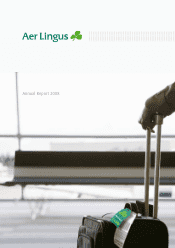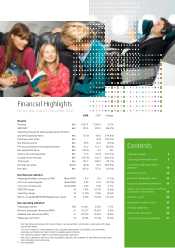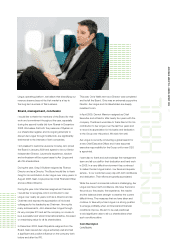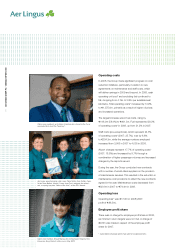Aer Lingus 2008 Annual Report Download - page 9
Download and view the complete annual report
Please find page 9 of the 2008 Aer Lingus annual report below. You can navigate through the pages in the report by either clicking on the pages listed below, or by using the keyword search tool below to find specific information within the annual report.
7
2008 has been a very difficult year for the international
airline industry as a whole. The industry experienced an
unprecedented increase in fuel prices in the first half of
2008 and extreme volatility in fuel prices in the second
half. This unprecedented fuel pricing environment,
combined with the most severe economic downturn of
recent years, severely impacted the performance of the
industry generally and Aer Lingus specifically. For 2008,
Aer Lingus is reporting an operating loss before employee
profit share and net exceptional items of €17.6m (2007:
profit of €88.5m) and a pre-tax profit before exceptionals
of €21.2m1 (2007: profit of €131.1m). At year end, as a
result of the loss for the year (€107.8m), and a decrease
in other reserves (€63.4m), shareholders’ funds had
decreased by €171.2m to €772.7m (2007: €943.9m).
Revenue
Total revenue rose by 5.6% to €1,357.4m. Passenger
revenue grew by 2.5% to €1,151.6m, with a total of
10,000,884 passengers carried in 2008, up by 696,205
(7.5%) on 2007. The total passenger load factor was
72.8%, down from 75.4% in 2007, driven by a capacity
increase of 13.9% year on year. Average fares decreased
by 4.6% overall, falling by 6.4% on short-haul and
increasing by 2.6% on long haul over 2007 levels due to
the increased fuel surcharge imposed during the year.
Revenue per passenger (fare yield plus ancillary revenue)
dropped by 1.7% versus 2007.
Short haul
Short haul capacity, measured in available seat kilometres
(ASKs), grew by 14.7% due to the full year effect of the
delivery of four A320’s in 2007, and the addition of one
A320 in June 2008, bringing the short haul fleet to 33 (27
A320, 6 A321). Capacity utilisation, measured by revenue
passenger kilometres (RPKs), increased relatively in line
with capacity, increasing by 13.6%. Aircraft utilisation
continued to increase, with average daily block hours
utilisation increasing to 10.4, an increase of 3.0% on 2007.
Total short haul passengers carried increased by 8.3% to
8,736,840 while the average short haul fare decreased
by 6.4% or €6.02 to €87.75. The reduction in short haul
fares was partly offset by the growth in ancillary revenue
per passenger of €3.29 or 28.2%.
Three additional A320s joined the fleet in March and April
2009, on operating leases, to operate on the new London
Gatwick base. We will reduce the Dublin based fleet by
one A320 due to the weakening of demand ex-Ireland.
There are orders placed for a further four A320s for delivery
between 2010 and 2011. These will bring the total short
haul fleet to 40 aircraft. Short haul capacity, measured in
ASKs, will grow by 9.4% in 2009 versus 2008. Further
consideration is being given to Winter 2009 capacity in
light of the current trading environment.
Long haul
There was a significant increase in long haul capacity
in the first half of 2008 due to the addition in mid 2007
of two long haul aircraft, bringing the long haul fleet to
nine A330s. As a result of these new aircraft, long haul
capacity, measured in ASKs, grew by 13.0%. Capacity
utilisation, measured by RPKs, did not match capacity
increases, growing at 5.6%. Total long haul passengers
carried increased by 2.3% to 1,264,044 while the average
long haul fare increased by 2.6% to €304.49. Aircraft
utilisation continued to increase, with average daily block
hours utilisation increasing to 14.3, an increase of 2.1%
on 2007.
Capacity in 2009 will reduce compared to 2008 levels due
to the ongoing fleet refurbishment program over the Winter
08/09 period, and the suspension of the Los Angeles
route. In addition the reduction of the long haul fleet from
nine aircraft to eight aircraft means that long haul capacity,
measured in ASKs, for 2009 will be 13.6% below 2008.
Further consideration is being given to Winter 2009
capacity in light of the current trading environment.
Ancillary revenue
Ancillary revenue continued its significant growth pattern
in 2008. This category mainly comprises sales on board,
booking fees, baggage and excess baggage charges,
seat selection fees and car hire, hotel and insurance
commissions. Total ancillary revenue grew by 37.7%
to €149.7m (2007: €108.7m). This growth was also
achieved in ancillary revenue spend per passenger,
which grew by 28.2% to €14.97 (2007: €11.68).
Cargo
During 2008, Aer Lingus continued to carry cargo on long
haul routes, and on a small number of short haul routes
where the aircraft turnaround times permit. Total cargo
revenue increased by 5.5% to €50.3m (2007: €47.7m).
This was primarily driven by increases in fuel surcharge
revenue, which increased by 50.0% year on year. Average
yields reduced by 8.0%, while tonnes decreased by 3.1%.
Short haul tonnage continued to grow, reaching 4,536
(an increase of 34.8%), while long haul tonnage dropped
marginally, by 1.4%, to 23,408 tonnes.
AER LINGUS GROUP PLC - ANNUAL REPORT 2008
1 In the defence document issued on 22 December 2008, the Group forecast a Profit in 2008 (Profit being defined as reported profit for the year, after
finance income, finance costs and income tax but before exceptional items). Under that Profit definition, the 2008 result was e33.1m.






















